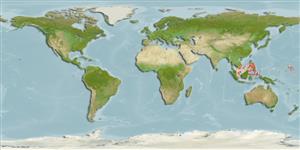>
Ovalentaria/misc (Various families in series Ovalentaria) >
Pomacentridae (Damselfishes) > Pomacentrinae
Etymology: Amphiprion: Greek, amphi = on both sides + Greek, prion, -onos = saw (Ref. 45335).
More on authors: Schultz & Welander.
Environment: milieu / climate zone / depth range / distribution range
Ecología
marino asociado a arrecife; no migratorio; rango de profundidad 3 - 40 m (Ref. 7247). Tropical; 25°C - ?; 15°N - 0°N
Western Pacific: Marshall Islands. Reported from New Caledonia (Ref. 9070).
Length at first maturity / Tamaño / Peso / Age
Maturity: Lm 7.5, range 7 - 8 cm
Max length : 12.0 cm TL macho / no sexado; (Ref. 9710)
Short description
Claves de identificación | Morfología | Morfometría
Espinas dorsales (total) : 10 - 11; Radios blandos dorsales (total) : 15 - 17; Espinas anales: 2; Radios blandos anales: 13 - 14. Black or orange with two vertical black-edged white bands, one behind the eye and one above the after. Black and orange color morphs believed to be dependent on which species of sea anemone the fish is associated with.
Life cycle and mating behavior
Madurez | Reproducción | Puesta | Huevos | Fecundidad | Larva
Oviparous, distinct pairing during breeding (Ref. 205). Eggs are demersal and adhere to the substrate (Ref. 205). Males guard and aerate the eggs (Ref. 205). Also Ref. 7471.
Allen, G.R., 1991. Damselfishes of the world. Mergus Publishers, Melle, Germany. 271 p. (Ref. 7247)
IUCN Red List Status (Ref. 130435: Version 2024-1)
Threat to humans
Harmless
Human uses
Pesquerías: sin interés; Acuario: Comercial
Herramientas
Special reports
Download XML
Fuentes de Internet
Estimates based on models
Preferred temperature (Ref.
123201): 27.7 - 29.1, mean 28.5 °C (based on 28 cells).
Phylogenetic diversity index (Ref.
82804): PD
50 = 0.5000 [Uniqueness, from 0.5 = low to 2.0 = high].
Bayesian length-weight: a=0.02570 (0.01622 - 0.04073), b=2.95 (2.81 - 3.09), in cm total length, based on LWR estimates for this species & (Sub)family-body (Ref.
93245).
Nivel trófico (Ref.
69278): 2.3 ±0.0 se; based on diet studies.
Generation time: 3.1 ( na - na) years. Estimated as median ln(3)/K based on 1
growth studies.
Resiliencia (Ref.
120179): Medio, población duplicada en un tiempo mínimo de 1.4-4.4 años (K=0.3).
Fishing Vulnerability (Ref.
59153): Low to moderate vulnerability (31 of 100).
